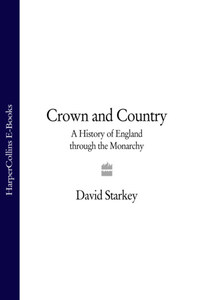Crown and Country
A History of England through the Monarchy
DAVID STARKEY
Copyright
Published by HarperPress in 2010
Copyright © Jutland 2010
1 London Bridge Street
London SE1 9GF
www.harpercollins.co.uk
The Monarchy of England: Volume I, The Beginnings first published by Chatto and Windus, a division of Random House, 2004 © Jutland 2004
Monarchy: From the Middle Ages to Modernity first published by HarperPress 2006 © David Starkey 2006
All rights reserved under International and Pan-American Copyright Conventions. By payment of the required fees, you have been granted the non-exclusive, non-transferable right to access and read the text of this ebook on-screen. No part of this text may be reproduced, transmitted, down-loaded, decompiled, reverse engineered, or stored in or introduced into any information storage and retrieval system, in any form or by any means, whether electronic or mechanical, now known or hereinafter invented, without the express written permission of HarperCollins ebooks
David Starkey asserts the moral right to be identified as the author of this work
A catalogue record for this book is available from the British Library
Some images were unavailable for the electronic edition.
HB ISBN 9780007307708
TPB ISBN 9780007307715
Ebook Edition © 2010 ISBN: 9780007424825
Version: 2018-08-08
To all those who worked with me on the Channel 4 Monarchy series for helping me understand history better and write it more clearly
Contents
Cover
Title Page
Copyright
Family Trees
Houses of Godwin and Wessex
Houses of Normandy, Anjou and the Plantagenets
Houses of York, Lancaster and Tudor
Houses of Tudor, Stuart and the Hanoverians
House of Windsor
Foreword
PART I - BEGINNINGS
Chapter 1 - The Shadow of Rome
Chapter 2 - Christian Kingship
Chapter 3 - Wessex
Chapter 4 - Triumph and Disaster
Chapter 5 - Confessor and Conquest
PART II - THE MEDIEVAL MONARCHY
Chapter 6 - Subjugation
Chapter 7 - Sons of Conquest
Chapter 8 - The Triumphant King
Chapter 9 - Civil War
Chapter 10 - ‘Touch Not Mine Anointed’
Chapter 11 - The Curse of Anjou
Chapter 12 - War Monarchy
Chapter 13 - Death of a Dynasty
PART III - THE IMPERIAL CROWN
Chapter 14 - The Man Who Would Be King
Chapter 15 - King and Emperor
Chapter 16 - Shadow of The King
Chapter 17 - Rebellion
Chapter 18 - New Model Kingdom
PART IV - EMPIRE
Chapter 19 - Restoration
Chapter 20 - Royal Republic
Chapter 21 - Britannia Rules
Chapter 22 - Empire
Chapter 23 - The King is Dead, Long Live The British Monarchy!
PART V - MODERNITY
Chapter 24 - The Modern Monarchy
Chapter 25 - New Kingdom
Index
Also By David Starkey
About the Publisher
HOUSES OF GODWIN AND WESSEX
HOUSES OF NORMANDY, ANJOU AND THE PLANTAGENETS
HOUSES OF YORK, LANCASTER AND TUDOR
HOUSES OF TUDOR, STUART AND THE HANOVERIANS
Foreword
THIS BOOK IS THE STORY of the crown of England and of those who wore it, intrigued for it and died for it. They include some of the most notable figures of English and British history: Alfred the Great and William the Conqueror, who shaped and reshaped England; the great Henrys and Edwards of the Middle Ages, who made England the centre of a vast European empire; Henry VIII, whose mere presence could strike men dumb with fear; Elizabeth I, who remains as much a seductive enigma to us as she was to her contemporaries; and Charles I, who redeemed a disastrous reign with a noble, sacrificial death as he humbled himself, Christ-like and self-consciously so, to the executioner’s axe.
Such figures leap from the page of mere history into myth and romance. I have painted these great royal characters – and the dozens of other monarchs, who, rightly or wrongly, have left less of a memory behind – with as much skill as I could.
But this is not a history of Kings and Queens. And its approach is not simply biographical either. Instead, it is the history of an institution: the Monarchy. Institutions – and monarchy most of all – are built of memory and inherited traditions, of heirlooms, historic buildings and rituals that are age-old (or at least pretend to be). All these are here, and, since I have devoted much of my academic career to what are now called Court Studies, they are treated in some detail.
But the institution of monarchy – and I think this fact has been too little appreciated – is also about ideas. Indeed, it is on ideas that I have primarily depended to shape the structure of the book and to drive its narrative. These are not the disembodied, abstract ideas of old-fashioned history. Instead, I present them through lives of those who formulated them. Sometimes these were monarchs; more usually they were advisers and publicists. Such men – at least as much as soldiers and sailors – were the shock-troops of monarchy. They shaped its reaction to events; even, at times, enabled it to seize the initiative. When they were talented and imaginative, monarchy flourished; when they were not, the crown lost its sheen and the throne tottered.
So monarchy depends on its servants: its advisers and ideologues; its painters, sculptors and architects, and – not least – its historians. And these, too, are given voice, sometimes as chorus to the swelling scene, occasionally as actors themselves.








